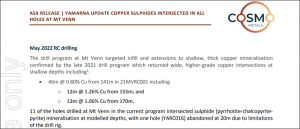Mineralisation Materialised
What is Mineralisation? The Term Defined and its Use Explained
The term “mineralisation” is used 45 times in the AusIMM Australasian Code for Reporting of Exploration Results, Mineral Resources and Ore Reserves (also known as the JORC 2012 Code), but it is not defined in the JORC code.
The JORC 2012 Code does not define “mineralisation”
But yet… exploration companies use the term “mineralisation” a lot. It’s what explorers look for. But what is it?
A brief search on the Internet leaves the researcher none the wiser.
So, what is “mineralisation”?
The American Geological Institute definition of mineralization is: The process or processes by which a mineral or minerals are introduced into a rock, resulting in an economically valuable or potentially valuable deposit. This is a general term, incorporating various types (e.g. metallization) and modes (e.g. fissure filling, impregnation, replacement) of mineralization.
My definition of the term “mineralisation” is: The occurrence of a concentration of a mineral (or minerals), or a metal (or metals) above normal levels in a rock.
Some important things to point out.
My definition “mineralisation” does not imply economic concentrations of minerals (or metals). “Copper mineralisation” in a drill hole does not mean that it is economic, or even potentially economic.
Also… my definition of “mineralisation” is not limited to concentrations of economic minerals/metals. For instance, mineralisation may be reported in a drill hole that includes concentrations of pyrite. For a most-part pyrite is not a mineral of economic value.
“Mineralisation” does not imply economic concentrations [grades] of minerals (metals), nor concentrations of economic minerals (metals).
My definition is more reflective of how the term “mineralisation” is used in explorers’ ASX announcements.
Taking an example of an explorer’s ASX announcement: Cosmo Metals (CMO) “Yamarna Update Copper Sulphides Intersected in all Holes at Mt Venn” (20 June 2022).
Cosmo refer to the intersection of “….sulphide (pyrrhotite-chalcopyrite-pyrite) mineralisation at modelled depths….” There is no inference of grade or economics. And, of the three sulphides mentioned, only chalcopyrite is of economic importance as it is the only one that contains an economic metal – copper.
Excerpt below: From Cosmo Metals (CMO) “Yamarna Update Copper Sulphides Intersected in all Holes at Mt Venn” (20 June 2022), cut and paste of the top of page 2.
The commentary is compliant with the JORC 2012 Code and is not misleading.

A further excerpt below: From Cosmo Metals (CMO) “Yamarna Update Copper Sulphides Intersected in all Holes at Mt Venn” (20 June 2022), cut and paste of the middle of page 2.
“…… intersected narrow zones of sulphide mineralisation…..

An economic deposit comprises zones of economic mineralisation and zones of uneconomic mineralisation. Economic zones of mineralisation comprises mineral (metal) concentrations that can be extracted for a profit. “Grade of economic minerals (metals) is king.”
Uneconomic zones of mineralisation comprises mineral (metal) concentrations that have grades that are too low, and/or comprise concentrations of non-economic minerals (metals), such as pyrite.
In a large porphyry system, for example, maybe 50% of the deposit comprises economic copper mineralisation. The other 50% comprises pyrite mineralisation. It’s all mineralisation but only half is economic.
There are examples of the use of the term “mineralisation” in many explorers’ announcements that do not and/or should not infer grade or economics.
Do not be beguiled by this term. Remember that mineralisation does not equal economics.



